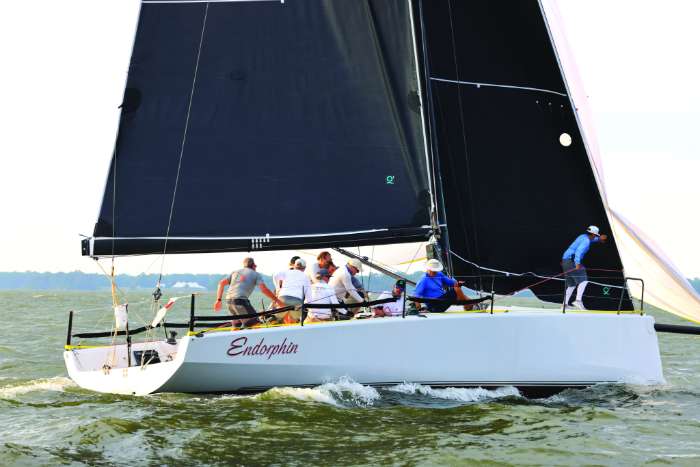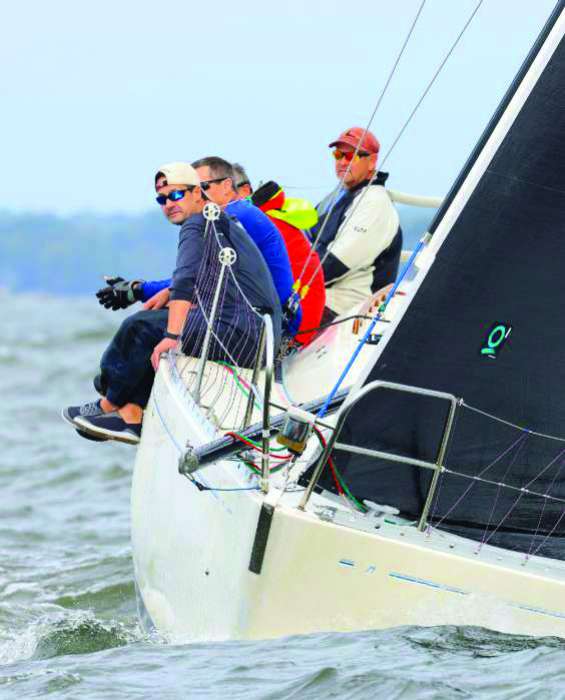Tips for Racing Sailors on Practicing Like You Race
Recently I wrote about jumpstarting your sailboat racing season. One of the key items discussed was organizing a practice session before scheduled racing actually begins. This should be a mandatory day with the entire team; no exceptions. I also pushed the idea that this was the best time to hire a coach. They are worth every dime. Better still is that a coach can provide a coach boat and marks to help you organize your practice time. So, what do you do when you go out with your team for that first weekend?

Repetition
I know this sounds absurdly simplistic, but sailing is a sport, and like all other sports it takes repetition. Even bad golfers go out and hit balls before they try to play a round. We can’t expect to tack, gybe, and douse spinnakers effectively without working on it, yet for most of us we expect to just show up on the weekend and have everything work. Start slowly. Go through a series of tacks, then sets, then gybes, to choreograph the required ballet and get everyone certain of what their jobs are in each evolution. You should allow time to discuss to make sure that all are on the same page.
Practice like you race
If you are going to make the effort, go all in. Everybody in the crew has to be there. You need to leave the dock at a defined time. The boat needs to be fully rigged and ready to go before you leave. Proper gear on, crew ready to go. Don’t wait to figure out the right outfit until you are on the water. You need to jump right into it. Get the sails up; don’t lollygag. Get the boat setup for upwind and sail in a straight line for awhile to get everyone settled in.
Next, work on tacks, going through a half dozen or so until the ballet is smooth. Find a weather and leeward mark. It is important to have real marks so that the whole crew can picture what is coming and prepare accordingly. Setting or dousing a spinnaker at an imaginary mark doesn’t work. Start doing laps. Give yourself enough room so that you can do four to five gybes per run. Too long and the upwind legs will become a slog, and you will not learn anything. Often, you can start with a longer windward leeward to get organized and shorten up to increase the intensity.
If things go badly with a maneuver, stop and get reorganized. It is not a bad idea to take a break after a couple laps to review what is working and what needs fixing. A high-intensity, focused practice that has a defined beginning and end is better than a long drawn-out session with no clear limits or defined goals.
Practice with a partner
The only way to work on boat speed is with a training partner. You are always fast when sailing by yourself. A partner will help keep your whole team focused. To work on upwind speed a proper line up is key. You need to be no more than two or three boat lengths apart, with the bows even going upwind. Farther apart and there will be too many variables. If one boat is clearly gaining and getting into too much separation, they should slow down and re-group.
After sailing for awhile, switch sides (leeward boat should become the windward boat). Switch over to doing laps once you are comfortable with the upwind setup. Use a radio to communicate or signals so that you can plan your tacks and agree on which marks to use. Doing laps with a partner will help your mechanics by introducing a higher level of intensity. Your partner can be one of your most valuable assets at a regatta. Plan to go out for each day’s racing at the same time. Sail together for a half hour or so upwind in the course area to work on speed, and set spinnakers and work on the downwind leg.
If you have time, you can do a second beat where each boat takes a side. It can provide tacticians with a good clue as to which side is favored. When you get back to the dock at the end of the day compare notes on rig settings, trim, and tactical decisions. Both teams will be better at the end of the regatta, and the camaraderie practicing together engenders is a plus.

Drills for only one boat
One of the most difficult maneuvers to get right is the turn at the leeward mark as you transition from downwind to upwind. It is a big turn, nearly 180 degrees, and demands smooth coordination between mechanics (taking the spinnaker down) and the speed team (driver and trimmers). The hard part is the rate of turn and matching trim to turn. The goal is the classic “in-wide, out-close” turn that starts wide and ends up with the boat just arriving at full upwind angle as the bow passes the mark. A deceptively simple drill to ingrain the mechanics of this turn can be done all by yourself.
First, take the spinnaker out of the equation. Approach a downwind mark on broad reach (true wind angle between 140-150 for realism), with just mainsail and jib. Practice making a smooth in-wide, out-close turn with coordinated trim. Don’t get ahead on the trim (trimmers love to cheat and pull sails in early). As you pass the mark, take a look back and see how close you got to full upwind trim and angle. Sail upwind for a minute or so, tack, bear away, and repeat. Five to seven repetitions will give drivers and trimmers a good sense of how wide, when to start the turn, and how fast to trim.
Drills for two or more boats
The key to a good start is being on time with speed, but the real measure of success is can you continue for two to three minutes on starboard without being forced to tack by the boats on either side? “Holding a lane” is tricky. A good way to practice is to have the boats line up approximately two boat lengths apart on a beam reach. At an agreed upon signal, turn up to close hauled.
Again, practice a smooth turn with coordinated trim up to close hauled and settle in for three minutes, working on holding height and fore and aft position on boats above and below. This simulates a good, even start and allows you to focus on speed and height without having to battle for the position to begin with.
Practice starts
Starting is the hardest part of the game and perhaps the most important. It is also the most difficult to practice, which is why sailors who have come up through collegiate programs with organized coaching and literally hundreds of starts a season have a big advantage. That is why any clinic or organized practice is an extended series of rolling practice starts.
Timing can vary depending on wind conditions, but five-minute intervals usually work well. Start, sail up wind for a minute or two, and bear off back to the starting area to do it again. In one hour you can get 12 starts in. There is no substitute. All it takes is a group of boats, a committee boat, and a mark. It is not as difficult to organize as you think, and your team will come away with dramatically improved techniques and confidence.
Questions? Email [email protected]
Find more great racing tips.




